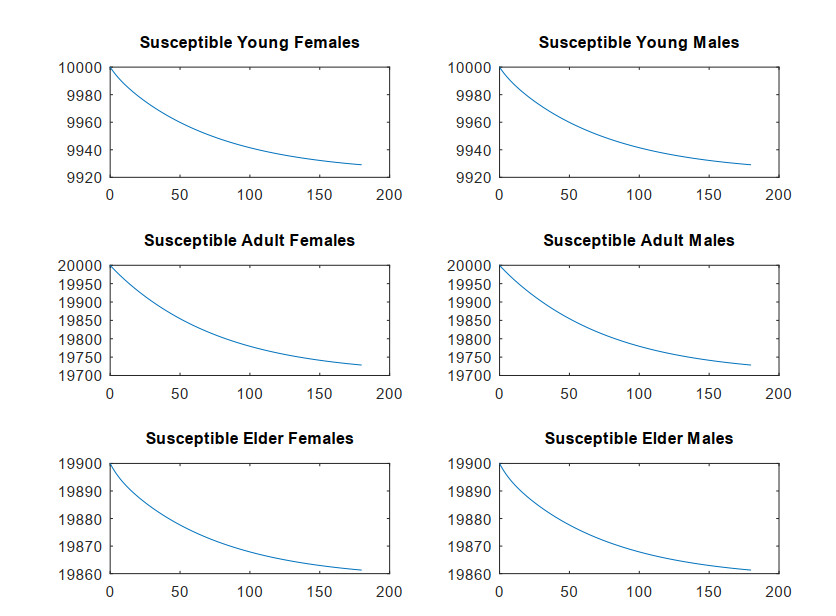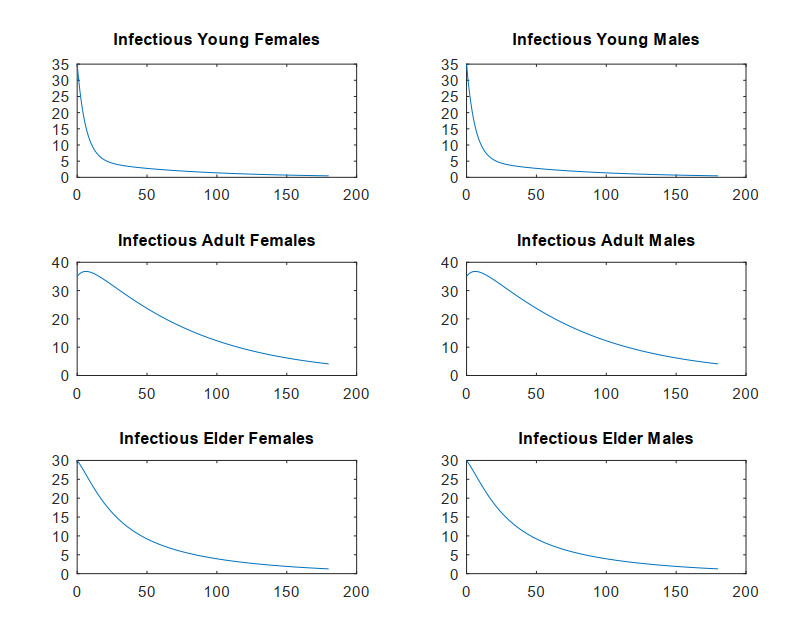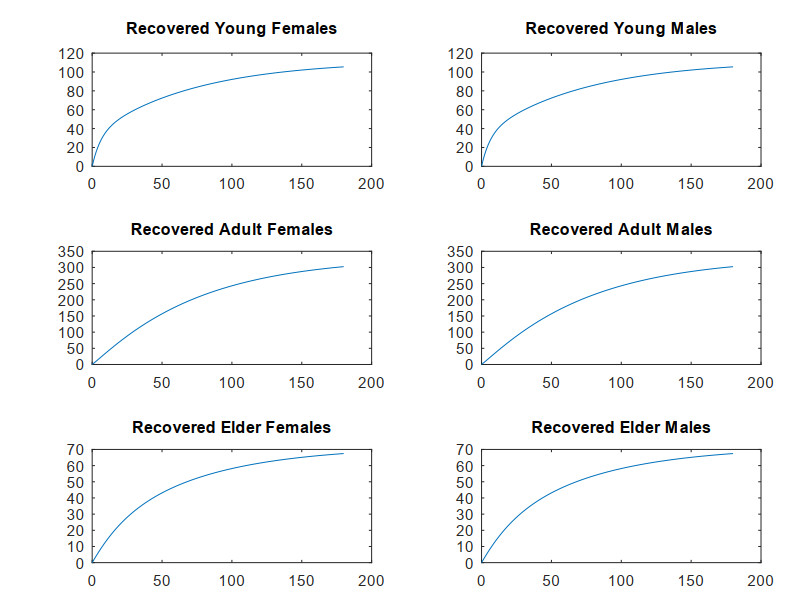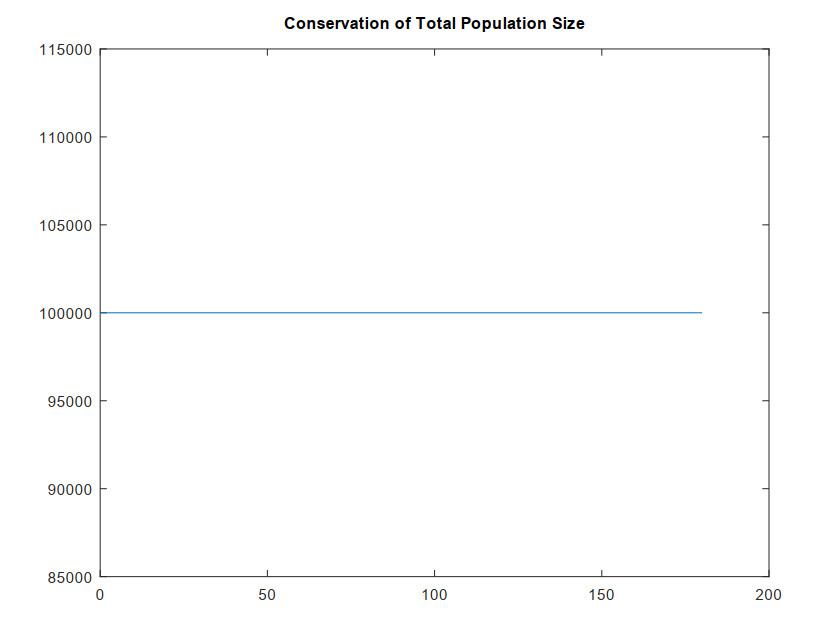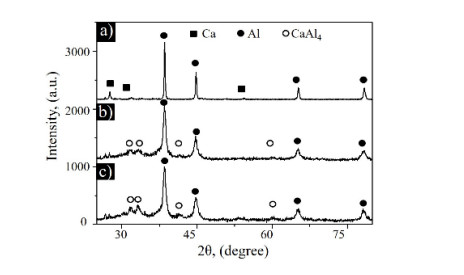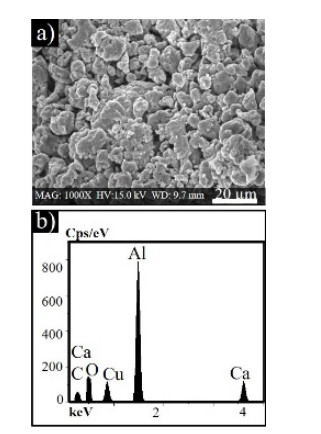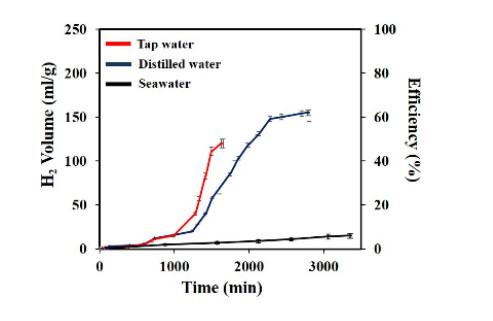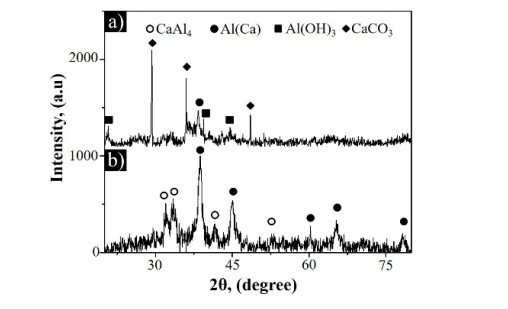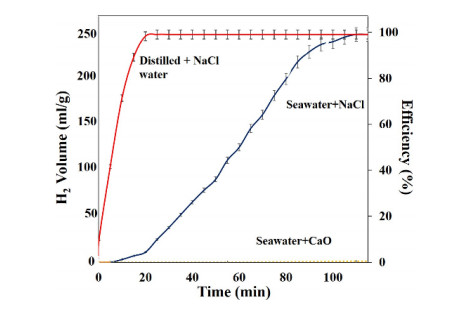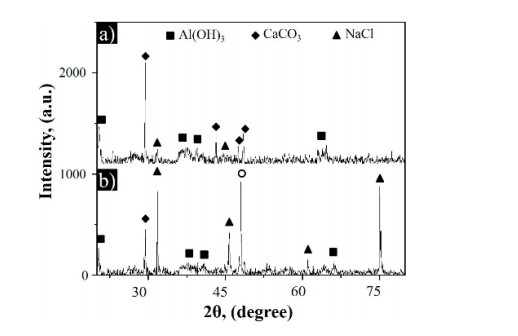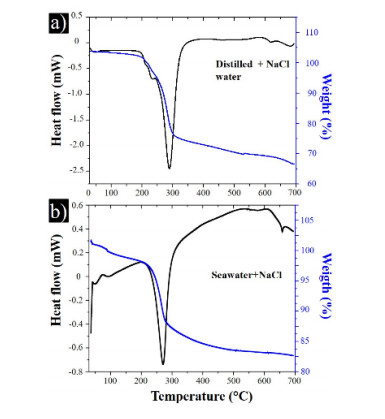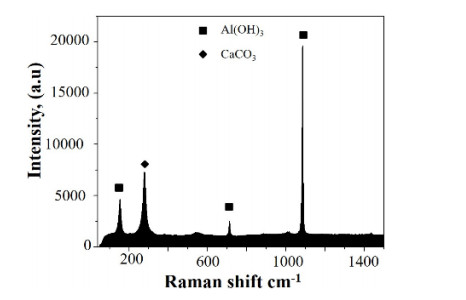In this study, the Al–20at%Ca alloy was synthesized by mechanical alloy from the elemental powder mixture. Subsequently, the alloy particles were reacted at room temperature to determine the amount of hydrogen released. For these purposes, the powders reacted with different types of water, such as distilled water, tap water, and seawater, and also in the presence of NaCl and CaO additives. Both milled samples and reaction powders were analyzed by X-ray diffraction (XRD), scanning electron microscopy (SEM), transmission electron microscopy (TEM), FT-IR, and Raman spectroscopy (RS). The XRD patterns of the powders prepared show a nanocrystalline alloy consisting of a solid-cubic solution of Al and the tetragonal intermetallic phase CaAl4. Studies of XRD and SEM, as well as direct measurements of H2, indicated that the best results of H2 generation were obtained when the alloy reacts with distilled water. Both NaCl and CaO additives improve hydrogen generation, reaching 100% efficiency in distilled water and seawater, and without induction time. Samples with a combination of NaCl and distilled water showed the best reaction times to generate the entire theoretical amount of hydrogen. The XRD and DSC–TGA standards also confirmed the presence of bayerite Al(OH)3 as a secondary reaction product.
1.
Introduction
1.1. Motivation
Mathematical models of disease spreading date back to the beginning of the twentieth century when Kermack and McKendrick published their famous epidemiological SIR model [1]. Since its invention, many researchers have relied heavily on these basic assumptions and have established more advances models [2,3,4]–only to name a few publications and references therein. Additionally, networks in epidemiology have been recently considered to describe dynamics of disease spreading and spreading patterns [5,6,7,8].
Special attention has been currently attracted by structured models which take age or spatial structure into account [9,10]. However, transmission rates depend on age structure as well as sex structure in general. For that reason, we develop a simple age- and sex-structured SIR model for short-time prediction because we want to keep modeling as interpretable as possible [12]. Therefore, we structure our population by both sexes and same size age groups.
Due to current epidemics like COVID-19 [13], we decided to stay with a SIR-typed model because data are suited for this type of models. If we take a closer look at data from Robert-Koch Institute in Germany, the assumption of same size age groups will be acceptable for current data. Theoretically, we have to consider continuous age-structure as presented in [10]. After this short motivational introduction, we can state our contributions in this article.
1.2. Contributions
Our contributions can be summarized as follows.
1) We develop a time-continuous age- and sex-structured SIR model for short-term predictions with time-dependent transmission rates between susceptible and infectious people and time-dependent recovery rates.
2) At first, we show certain properties such as non-negativity and boundedness of solutions.
3) Additionally, we provide a thorough proof of global existence of solutions in time to our proposed system. We need non-negative and boundedness to conclude global existence and global uniqueness of the solution in time from inductive arguments based on Banach's fixed point theorem. This underlines usefulness of fixed point theorems for arguments regarding existence and uniqueness of solutions in different mathematical areas [11].
4) Furthermore, we prove monotonicity properties of the global unique solution and investigate analytically that it convergences to a disease-free equilibrium.
5) Afterwards, we introduce a time-discrete problem formulation which heavily relies on an explicit-implicit formulation of the right-hand-side function. As a consequence, our numerical solution scheme becomes unconditionally stable with respect to chosen time increments. We further show that all properties of the time-continuous formulation transfer to the time-discrete case.
6) We finally summarize our numerical solution scheme in pseudo-code and one numerical example stresses our theoretical findings.
1.3. Structure
Our article is structured as follows. After our motivational introduction of Section 1, we formulate the time-continuous age- and sex-structured SIR model in Section 2. Additionally, we analyze global existence and global uniqueness, non-negativity, boundedness, monotonicity and long-time behavior of the solution of this model. After that, we propose an explicit-implicit numerical solution scheme in Section 3. Here, we show that all properties of our time-continuous model transfer to our time-discrete problem formulation. We present one numerical example to illustrate our theoretical findings in Section 4 and finally, we conclude our article with some remarks on possible future research directions in Section 5.
2.
Time-continuous problem
The aim of this section is the description and analysis of an age- and sex-structured SIR model. For that purpose, we briefly state our model and its assumptions. At first, we prove global existence based on a modified version of Gr{ö}nwall's Lemma. Afterwards, we provide proofs for non-negativity, boundedness, global uniqueness, monotonicity and long-time behavior of our model's solution.
2.1. Mathematical background material
To especially state global existence and global uniqueness of the solution of our age- and sex-structured SIR model, we need to introduce some theoretical background material regarding nonlinear ordinary differential equations. Let us first recall Lipschitz continuity of a function on Euclidean spaces.
Definition 2.1 ([14,Subsection 3.2]). Let d1,d2∈N. If S⊂Rd1, a defined function F:S⟶Rd2 is called Lipschitz continuous on S if there exists a non-negative constant L≥0 such that
holds for all x,y∈S. Here, ‖⋅‖ denotes a suitable norm on the corresponding Euclidean space.
Let U⊂Rd1 be open, let F:U⟶Rd2. We shall call F locally Lipschitz continuous if for every point x0∈U there exists a neighborhood V of x0 such that the restriction of F to V is Lipschitz continuous on V.
We consider an initial-value problem
where z(t)=(x1(t),…,xn(t)) denotes our solution vector. Our vectorial function is represented by G(t,z(t))=(g1(t,z(t)),…,gn(t,z(t))) and z0∈Rn are our given initial conditions. To conclude global existence, we can apply the following theorem that is a direct consequence of Gr{ö}nwall's lemma.
Theorem 2.2 ([14,Theorem 4.2.1]). If G:[0,∞)×Rn⟶Rn is locally Lipschitz continuous and if there exist non-negative real constants B and K such that
holds for all z(t)∈Rn, then the solution of the initial value problem (2.2) exists for all time t∈R and moreover, it holds
for all t∈R.
Finally, we need Banach's fixed point theorem to derive global uniqueness.
Theorem 2.3 ([15,Theorem V.18]). Let (X,ϱ) be a complete metric space with the metric mapping ϱ:X×X⟶[0,∞). Let T:X⟶X be a strict contraction, i.e. there exists a constant K∈[0,1) such that ϱ(Tx,Ty)≤K⋅ϱ(x,y) holds for all x,y∈X. Then the map T has a unique fixed point.
2.2. Time-continuous problem formulation
At first, we define the supremum norm of a continuous function f:[0,∞)⟶R. It is given by
An equivalent definition can be given for continuous functions on intervals [a,b]. Let us now state the model's assumptions [10,16,17]:
1) The population size N is fixed over time t, i.e. N(t)=N for all t∈[0,∞);
2) We divide the population into three homogeneous subetaoups, namely susceptible people (S), infectious people (I) and recovered people (R). We can clearly assign every individual to exactly one subetaoup. Hence, we obtain
for all t∈[0,∞);
3) We further distinguish our subetaoups. Let Na∈N be the number of age groups and let f and m be the subscripts for female and male persons respectively. Let k∈{1,…,Na} be arbitrary. We denote the k-th female susceptible subetaoup by Sf,k and the k-th male susceptible subetaoup by Sm,k. Consequently, it is clear how we denote the infectious and recovered subetaoups;
4) Additionally, no births and deaths occur;
5) The time-varying transmission rates βSm,j,Is,k:[0,∞)⟶(0,∞) are Lipschitz continuous and continuously differentiable for fixed j∈{1,…,Na}, arbitrary k∈{1,…,Na} and arbitrary s∈{f,m}. In addition to that, there exists a positive constant Mβ>0 such that ‖βSm,j,Is,k‖∞≤Mβ for all t≥0, arbitrary s∈{f,m} and arbitrary j,k∈{1,…,Na};
6) The time-varying recovery rates γIs,k:[0,∞)⟶(0,∞) are Lipschitz continuous and continuously differentiable for arbitrary s∈{f,m} and arbitrary k∈{1,…,Na}. Additionally, there are positive constants Mγ>0 and mγ>0 such that ‖γIs,k‖∞≤Mγ and γIs,k(t)≥mγ for all t≥0, arbitrary s∈{f,m} and arbitrary k∈{1,…,Na}.
For abbreviation, we write g′(t):=dg(t)dt for the first derivative of a differentiable function g at time t. Our equations of the time-continuous age- and sex-structured SIR model read
with susceptible initial conditions Ss,j(0)=S1,s,j>0, infectious initial conditions Is,j(0)=I1,s,j≥0 and recovered initial conditions Rs,j(0)=R1,s,j≥0 for arbitrary s∈{f,m} and arbitrary j∈{1,…,Na}. At least one initial condition of the infectious subetaoups should be positive. Obviously, it holds
such that population size is preserved for all t≥0.
2.3. Non-negativity and boundedness
We examine non-negativity and boundedness of (2.6).
Lemma 2.4. We obtain
for arbitrary s∈{f,m}, for all j∈{1,…,Na} and for all t≥0 with respect to (2.6).
Proof. We divide our proof into four parts. Let s∈{f,m} and j∈{1,…,Na} be arbitrary in the following.
1) We consider
since Ss,j(t) is contained in both summands and does not depend on the summation index k. Hence, we can put this term outside our considered sum. Division by Ss,j(t) now yields
and since we are able to write S′s,j(t)=dSs,j(t)dt, we can rewrite this equation by
through separation of variables. By integration on the respective time interval [0,t], we observe that
holds. We finally obtain
Hence, it holds Ss,j(t)>0 for all t≥0 by our approach of separation of variables. This procedure is feasible because our initial conditions for susceptible people are positive.
2) We examine
under the initial condition Is,j(0)=I1,s,j≥0 for arbitrary s∈{f,m} and arbitrary j∈{1,…,Na}. Let us additionally assume that Is,k(0)=I1,s,k≥0 for arbitrary s∈{f,m} and arbitrary k∈{1,…,Na} with k≠j. At least one initial condition I1,˜s,˜j should be positive. This implies
for all derivatives of initial conditions for infectious subetaoups where the initial conditions are zero at time t=0 since all Ss,j(0)>0 by assumption and all Is,k(0)≥0 with at least one positive function I˜s,˜j(0)>0 by assumption. Hence, there exists a time T1>0 such that Is,j(T1)>0 for all s∈{f,m} and all j∈{1,…,Na}. Additionally, it holds Is,j(t)≥0 for all t∈[0,T1] for all s∈{f,m} and all j∈{1,…,Na}.
Now, we interpret T1>0 as our new starting point for our argument. We have to distinguish two cases.
Case 1: Let T2>T1 and let Is1,j1(T2)=0 be one function of an infectious subetaoup which is non-negative for all t∈[0,T2]. This is feasible due to continuity of these functions. Let there be at least one function of infectious subetaoups which is positive at t=T2. As proven in the previous inequality, this implies I′s1,j1(T2)>0. However, this yields the existence of a positive constant δ>0 such that Is1,j1(t)<0 for all t∈(T2−δ,T2) by continuity. This contradicts our assumption. Hence, all functions of infectious subetaoups stay non-negative - even positive - in this case. By induction, this even holds on future time subintervals.
Case 2: Let T2>T1 and let Is,j(T2)=0 for all s∈{f,m} and all j∈{1,…,Na}. This implies the status of disease-free equilibrium for all future time points.
Hence, (2.6) preserves non-negativity with respect to all infectious subetaoups.
3) By our second property and integration of
on the time interval [0,t], we obtain
It yields full non-negativity preservation of our non-linear ordinary differential equation system (2.6).
4) Our upper bound is a direct consequence of
for all t≥0 and our proof is complete.
2.4. Global existence
We now prove a global existence theorem of (2.6) based on Theorem 2.2.
Theorem 2.5. The non-linear first order ordinary differential equation system (2.6) has at least one global solution, i.e. these possible solutions exist for all t≥0.
Proof. We define the six vectors
which build our solution vector
Now, we define G:[0,∞)×R6⋅Na⟶RNa by (2.6) in a straightforward manner. By applying maximum norms, triangle inequalities, non-negativity and boundedness by Lemma 2.4, we obtain
for all j∈{1,…,Na} and this yields
Hence, Theorem 2.2 implies global existence of the system's possible solutions in time.
2.5. Global uniqueness
Now, we are able to prove global uniqueness of our time-continuous problem formulation (2.6).
Theorem 2.6. The non-linear first order ordinary differential equation system (2.6) has exactly one global unique solution in time.
Proof. 1) At first, we need one inequality for our proof. Let x1,x2,y1,y2∈R be arbitrary. By the triangle inequality, we obtain
2) Let
be two solutions of our initial value problem (2.6) with same time-varying coefficients and same initial value conditions. Let us consider
for arbitrary s∈{f,m} and arbitrary j∈{1,…,Na}. Application of the triangle inequality and assumptions on our time-varying coefficients yields
Since all functions are bounded above by the population size N, we obtain
by application of our inequality from the first step of this proof.
3) Let us now consider
By integration on the time interval [0,τ], we obtain
Application of the triangle inequality and the second part of this proof yields
4) Furthermore, it holds
We obtain
5) Combining the previous steps, we conclude
on the time interval [0,τ]. Choose τ:=18⋅(Na+1)⋅max{Mβ,Mγ}. This implies
and hence, the solution is unique on the time interval [0,τ] by Banach's fixed point theorem. Inductively, all previous steps hold on following time intervals [k⋅τ,(k+1)] with arbitrary k∈N and initial conditions at time point t=k⋅τ. Therefore, we conclude that the solution is unique for all t≥0 which proves our assertion.
2.6. Monotonicity and long-time behavior
We conclude our analysis of our time-continuous problem formulation (2.6) by an investigation of monotonicity and long-time behavior.
Theorem 2.7. We obtain the following properties for arbitrary s∈{f,m} and for all j∈{1,…,Na}:
1) Ss,j is monotonically decreasing and there exists a number S⋆s,j≥0 such that limt→∞Ss,j(t)=S⋆s,j holds. Additionally, we obtain S⋆s,j>0;
2) Rs,j is monotonically increasing and there exists a number R⋆s,j≥0 such that limt→∞Rs,j(t)=R⋆s,j;
3) Is,j is Lebesgue-integrable on [0,∞) and we get limt→∞Is,j(t)=0;
4) Our system (2.6) always converges to a disease-free equilibrium
for all solution functions of (2.6).
Proof. We divide our proof in four parts. Let s∈{f,m} and j∈{1,…,Na} be arbitrary.
1) Since 0≤Ss,j(t)≤N and 0≤Is,j(t)≤N hold for all t≥0 by Lemma 2.4, we obtain S′s,j(t)≤0 for all t≥0. By separation of variables, we know that
is valid and this implies
Since Ss,j is monotonically decreasing, bounded below by zero and
there exists a positive real number S⋆s,j such that we obtain the limit limt→∞Ss,j(t)=S⋆s,j.
2) By considering R′s,j(t)=γIs,j(t)⋅Is,j(t)≥0 from Lemma 2.4, we conclude that Rs,j is monotonically increasing. Since Rs,j is further bounded above by N according to Lemma 2.4, there exists a positive real number R⋆s,j such that limt→∞Rs,j(t)=R⋆s,j.
3) We have R′s,j(t)=γIs,j(t)⋅Is,j(t) according to our non-linear differential equation system (2.6). Integration on [0,∞) yields
This yields
and hence, Is,j is Lebesgue-integrable on [0,∞). This shows limt→∞Is,j(t)=0.
4) Remember the notation introduced at the beginning of the proof of Theorem 2.5. By our three aforementioned properties, we obtain the limiting vector
and this vector represents the disease-free equilibrium. Hence, our non-linear differential equation system converges to the disease-free equilibrium. This finishes our proof.
3.
Explicit-implicit numerical solution algorithm
Here, we develop an explicit-implicit time-discrete variant of our time-continuous age- and sex-structured SIR model. We organize this section similar to the previous one. Our constructive goal in this section is to present a numerical solution scheme that captures as many properties of its continuous analogue as possible.
Let us assume that our time interval [0,T] can be divided by a strictly increasing sequence {tp}Mp=1 for M∈N with t1=0 and tM=T. To distinguish continuous and time-discrete solutions, all time-discrete functions are denoted by Snums,j(tp) for example. We additionally assume that time-continuous and time-discrete time-varying transmission rates and recovery rates coincide for all times.
3.1. Time-discrete problem formulation
Here, we state our explicit-implicit time-discrete problem formulation
of the time-continuous SIR model (2.6) for all p∈{1,…,M−1} and for all subscripts of age groups j∈{1,…,Na}. Our initial conditions read
for arbitrary s∈{f,m} and all j∈{1,…,Na} with at least one initial condition of infectious subetaoups to be positive. For abbreviation, we write in short Δp+1=(tp+1−tp) for all p∈{1,…,M−1} in the following. This explicit-implicit time-discrete problem formulation obviously fulfills
for all p∈{1,…,M−1}.
3.2. Solvability
Let us proceed with unique solvability of our numerical scheme (3.1).
1) We observe from
that
holds for arbitrary s∈{f,m}, for all j∈{1,…,Na} and for all p∈{1,…,M−1}. Here, the sum in the denominator is given by
2) We see from
that
holds for arbitrary s∈{f,m}, for all j∈{1,…,Na} and for all p∈{1,…,M−1}.
3) We conclude from
that
holds for arbitrary s∈{f,m}, for all j∈{1,…,Na} and for all p∈{1,…,M−1}.
4) Hence, all our computations demonstrate that our numerical solution scheme (3.1) is uniquely solvable. We even infer that, in contrast to typical explicit Euler-time stepping schemes, it is unconditionally stable and we avoid non-linearities as in implicit Euler-time stepping schemes. We summarize our computations and our observations in the following theorem.
Theorem 3.1. Our numerical solution scheme (3.1) is uniquely solvable for all time steps. Additionally, it is also unconditionally stable.
Proof. Follow the above computations in Subsection 3.2.
3.3. Non-negativity and boundedness
Let us first remark that our initial conditions are non-negative. By induction, it follows that
hold from (3.3) - (3.5) for all s \in \left\{ f, m \right\} , all j \in \left\{ 1, \ldots, N_{a} \right\} and all p \in \left\{ 1, \ldots, M \right\} . Boundedness is a consequence of (3.2). Thus, we can state the following lemma.
Lemma 3.2. We obtain
for arbitrary s \in \left\{ f, m \right\} , for all j \in \left\{ 1, \ldots, N_{a} \right\} and for all p \in \left\{ 1, \ldots, M \right\} .
3.4. Monotonicity and long-time behavior
We continue this section with our theorem on monotonicity and long-time behavior of the solution of our explicit-implicit numerical scheme (3.1).
Theorem 3.3. We have the following properties:
1) The sequence \left\{ S^{ \text{num}}_{s, j} \left(t_{p} \right) \right\}_{p = 1}^{M} is monotonically decreasing and there exists a non-negative real number S^{\star, \text{num}} such that \lim\limits_{p \to \infty} S^{ \text{num}}_{s, j} \left(t_{p} \right) = S^{\star, \text{num}} ;
2) The sequence \left\{ R^{ \text{num}}_{s, j} \left(t_{p} \right) \right\}_{p = 1}^{M} is monotonically increasing and there exists a non-negative real number R^{\star, \text{num}} such that \lim\limits_{p \to \infty} R^{ \text{num}}_{s, j} \left(t_{p} \right) = R^{\star, \text{num}} ;
3) The sequence \left\{ I^{ \text{num}}_{s, j} \left(t_{p} \right) \right\}_{p = 1}^{M} fulfills \lim\limits_{p \to \infty} I^{ \text{num}}_{s, j} \left(t_{p} \right) = I^{\star, \text{num}} = 0
for arbitrary s \in \left\{ f, m \right\} and for all j \in \left\{ 1, \ldots, N_{a} \right\} .
Proof. 1) By Lemma 3.2, we know that the sequence \left\{ S^{ \text{num}}_{s, j} \left(t_{p} \right) \right\}_{p = 1}^{M} is bounded. Again by Lemma 3.2 and (3.3) - (3.5), we get
for arbitrary s \in \left\{ f, m \right\} , for all j \in \left\{ 1, \ldots, N_{a} \right\} and for all p \in \left\{ 1, \ldots, M - 1 \right\} . Hence, the sequence \left\{ S^{ \text{num}}_{s, j} \left(t_{p} \right) \right\}_{p = 1}^{M} is monotonically decreasing and it thus converges. This implies the existence of a non-negative real number S^{\star, \text{num}} such that \lim\limits_{p \to \infty} S^{ \text{num}}_{s, j} \left(t_{p} \right) = S^{\star, \text{num}} holds.
2) By Lemma 3.2, we know that the sequence \left\{ R^{ \text{num}}_{s, j} \left(t_{p} \right) \right\}_{p = 1}^{M} is bounded. Again by Lemma 3.2 and (3.3) - (3.5), we conclude
for arbitrary s \in \left\{ f, m \right\} , for all j \in \left\{ 1, \ldots, N_{a} \right\} and for all p \in \left\{ 1, \ldots, M - 1 \right\} . Hence, the sequence \left\{ R^{ \text{num}}_{s, j} \left(t_{p} \right) \right\}_{p = 1}^{M} is monotonically increasing and it thus converges. This yields the existence of a non-negative real number R^{\star, \text{num}} such that \lim\limits_{p \to \infty} R^{ \text{num}}_{s, j} \left(t_{p} \right) = R^{\star, \text{num}} holds.
3) Let us assume the contrary. This implies the existence of a positive real number I^{\star, \text{num}} such that \lim\limits_{p \to \infty} I^{ \text{num}}_{s, j} \left(t_{p} \right) = I^{\star, \text{num}} holds. By (3.4), we then know that all values of the sequence are positive from a certain sequence index. Hence, there exists a positive real number \tilde{I}^{ \text{num, min}} such that I^{ \text{num}}_{s, j} \left(t_{p} \right) \geq \tilde{I}^{ \text{num, min}} . Considering
from (3.5), we obtain
and summation by parts yields
from the mentioned time index L as our summation beginning. However, this contradicts our second property. Hence, \lim\limits_{p \to \infty} I^{ \text{num}}_{s, j} \left(t_{p} \right) = I^{\star, \text{num}} = 0 holds.
3.5. Convergence analysis
Here, we want to discuss convergence of our proposed numerical scheme (3.1).
Theorem 3.4. In addition to the assumptions of Subsection 2.2, all solution functions S_{s, j}, I_{s, j}, R_{s, j} \colon \left[0, \infty \right) \longrightarrow \left[0, N \right] are assumed to be continuously differentiable twice with globally bounded first and second derivatives. Additionally, all first derivatives of time-varying transmission rates and time-varying recovery rates are assumed to be globally bounded as well. Let \Delta_{p} \leq 1 for all p \in \mathbb{N} . If \max\limits_{p \in \mathbb{N}} \Delta_{p} \to 0 holds, the discrete solution of the numerical scheme (3.1) converges linearly towards the global unique continuous solution on a considered time interval \left[0, T \right] .
Proof. Since this proof become relatively technical, we briefly describe our strategy. At first, local errors between continuous and time-discrete solutions are considered. Afterwards, we need to take into account that errors propagate in time. Finally, we investigate cumulation of these errors which finalizes our proof. We adapt ideas from [18] and [19]. In general, we follow [19,Satz 74.1] and modify ideas for explicit Eulerian time-stepping schemes because our scheme is a mixture of explicit-implicit parts.
1) For investigation of local errors, we assume that
hold for arbitrary s \in \left\{ f, m \right\} and arbitrary j \in \left\{ 1, \ldots, N_{a} \right\} and we consider the time interval \left[t_{p}, t_{p + 1} \right] . Here, we thus only consider one time step and denote solutions by \widetilde{S_{s, j}^{ \text{num}} \left(t_{p + 1} \right)} , \widetilde{I_{s, j}^{ \text{num}} \left(t_{p + 1} \right)} and \widetilde{R_{s, j}^{ \text{num}} \left(t_{p + 1} \right)} respectively.
1.1) It first holds
and solving this equation for \widetilde{S_{s, j}^{ \text{num}} \left(t_{p + 1} \right)} yields
We consider \left| S_{s, j} \left(t_{p + 1} \right) - \widetilde{S_{s, j}^{ \text{num}} \left(t_{p + 1} \right)} \right| . It holds
Zero addition and application of the triangle inequality implies
We define the two terms
and
For I_{a} , we obtain
Application of the mean value theorem of calculus yields the existence of \xi_{a} \in \left(t_{p}, t_{p + 1} \right) such that
holds. This implies
For I_{b} , we obtain
Application of the triangle inequality and rearranging yields
Since
is valid, we obtain
By the mean value theorem of calculus, there exists \xi_{b} \in \left(t_{p}, t_{p + 1} \right) such that
holds. This implies
Here, { \beta ^{\prime}} denotes the vector of all derivatives of time-varying transmission rates. We conclude
and summarizing our results, this implies
1.2) From
we obtain
We consider \left| I_{s, j} \left(t_{p + 1} \right) - \widetilde{I_{s, j}^{ \text{num}} \left(t_{p + 1} \right)} \right| . It holds
Rearranging of these terms and application of the triangle inequality yields
We define the following three terms
and
I_{c} can be rewritten as
By the mean value theorem of calculus, there exists \xi_{c} \in \left(t_{p}, t_{p + 1} \right) such that
holds. This implies
For I_{d} , we obtain
Application of the triangle inequality implies
By the mean value theorem of calculus, there is \xi_{d} \in \left(t_{p}, t_{p + 1} \right) such that
holds. Hence, we conclude
Here, { \gamma ^{\prime}} denotes the vector containing all derivatives of time-varying recovery rates. We consider
By zero addition, we obtain
Application of the triangle inequality yields
We define the following three terms
and
Considering I_{e, 1} , there exists \xi_{e, 1} \in \left(t_{p}, t_{p + 1} \right) such that
holds due to the mean value theorem of calculus. Hence, we obtain
By the mean value theorem of calculus, there exists \xi_{e, 2} \in \left(t_{p}, t_{p + 1} \right) such that
is valid. Application of the triangle inequality yields
Now, we consider
By application of the triangle inequality, we obtain
By inequality (3.6) from Step 1.1), we know that
holds. This implies
Combining our results, we obtain
We define
We conclude
1.3) It holds
We consider \left| R_{s, j} \left(t_{p + 1} \right) - \widetilde{R_{s, j}^{ \text{num}} \left(t_{p + 1} \right)} \right| and obtain
Application of zero addition and the triangle inequality yields
By the mean value theorem of calculus, there are \xi_{f, 1}, \xi_{f, 2}, \xi_{f, 3}, \xi_{f, 4} \in \left(t_{p}, t_{p + 1} \right) such that
hold. This implies
and
By inequality (3.7) from Step 1.2), we know that
is valid. We infer that
holds. Summarizing our results, we obtain
and
in a short manner.
1.4) Conclusively, we obtain
from the inequalities (3.6), (3.7) and (3.8).
2) In reality, the points \left(t_{p}, S_{s, j}^{ \text{num}} \left(t_{p} \right) \right) , \left(t_{p}, I_{s, j}^{ \text{num}} \left(t_{p} \right) \right) and \left(t_{p}, R_{s, j}^{ \text{num}} \left(t_{p} \right) \right) do not lie on the continuous solution graph. For that reason, we must investigate how procedural errors S_{s, j}^{ \text{num}} \left(t_{p} \right) - S_{s, j} \left(t_{p} \right) , I_{s, j}^{ \text{num}} \left(t_{p} \right) - I_{s, j} \left(t_{p} \right) and R_{s, j}^{ \text{num}} \left(t_{p} \right) - R _{s, j} \left(t_{p} \right) propagate to the \left(p + 1 \right) -th time step. These estimates are going to be carried out in the following steps 2) and 3) of this proof.
2.1) At first, we must consider \left| S_{s, j}^{ \text{num}} \left(t_{p + 1} \right) - \widetilde{S_{s, j}^{ \text{num}} \left(t_{p + 1} \right)} \right| . Remember that \widetilde{S_{s, j}^{ \text{num}} \left(t_{p} \right)} = S_{s, j} \left(t_{p} \right) . Note that
and
are valid. Hence, we obtain
Application of the triangle inequality and zero addition yields
Summarizing this result, we obtain
2.2) Now, we consider \left| I_{s, j}^{ \text{num}} \left(t_{p + 1} \right) - \widetilde{I_{s, j}^{ \text{num}} \left(t_{p + 1} \right)} \right| . We first observe that
and
are valid from step 1.2). Application of the triangle inequality and zero addition yields
Using (3.10), we obtain
and the result reads
2.3) We consider \left| R_{s, j}^{ \text{num}} \left(t_{p + 1} \right) - \widetilde{R_{s, j}^{ \text{num}} \left(t_{p + 1} \right)} \right| . From step 1.3), we know that
and
hold. By application of the triangle inequality, this implies
Using inequality (3.11), we obtain
We conclude that
holds.
2.4) Now, we want to combine our results. Since s \in \left\{ f, m \right\} and j \in \left\{ 1, \ldots, N_{a} \right\} are arbitrary indices, we infer by inequalities (3.10), (3.11) and (3.12) that
holds because \Delta_{p + 1} \leq 1 by assumption. This yields
3) Finally, we can finish our proof of convergence. For abbreviation, we write
where \mathbf{z} \in \mathbb{R}^{6 \cdot N_{a}} is defined as in the proof of Theorem 2.5. Our proof is heavily based on the inequality
for all x \geq 0 . Note that t_{1} = 0 < t_{2} < \ldots < t_{M - 1} < t_{M} = T .
3.1) At first, we want to inductively prove that
holds for all p \in \left\{ 0, \ldots, M - 1 \right\} . Let p = 0 first. The inequality (3.14) is fulfilled. Let p = 1 to understand the concept. By application of the triangle inequality and inequalities (3.9) and (3.13), we see that
is valid. We now assume that
holds. We now want to show that (3.14) follows. We see that
holds. This proves (3.14) by induction.
3.2) Concluding our proof, we consider
from (3.14). We define \Delta : = \max\limits_{r \in \left\{ 2, \ldots, M \right\}} \Delta_{r} . We infer that
holds. If the initial conditions of our continuous and our time-discrete problem formulation coincide and \Delta \to 0 , the time-discrete solution convergences linearly towards the continuous solution. This proves our assertion.
3.6. Numerical solution algorithm
We briefly summarize our numerical solution algorithm for the time-discrete explicit-implicit numerical scheme (3.1) in Table 1. This summary is intended to give a brief overview of aspects which need to be considered during implementation. Especially, we state all inputs which are important for our time-discrete numerical scheme.
4.
Numerical example
In this section, we illustrate our theoretical findings by one synthetic data example. At first, we sum up all important information to set calculations up. Finally, we show the results and discuss these findings with respect to our theoretical results.
4.1. Setting
Let us provide our setting. In Table 2, we summarize the corresponding indices of population subetaoups. The total population is divided into six subetaoups. Now, we report the (time-varying) transmission rates \beta_{S_{s, j}, I_{q, k}} \colon \left[0, \infty \right) \longrightarrow \left[0, \infty \right) and (time-varying) recovery rates \gamma_{I_{s, j}} \colon \left[0, \infty \right) \longrightarrow \left[0, \infty \right) for arbitrary s, q \in \left\{ f, m \right\} and arbitrary j, k \in \left\{ 1, \ldots, N_{a} \right\} . These data can be found in Tables 3 and 4. This is an imaginary disease which spreads mainly in the adult population. All initial conditions of populations subetaoups are described in Table 5. The final time is set T = 180 with an equidistant time sequence
and this implies M = 181 . The total population size reads N = 100000 due to Table 5. Hence, all data are available for our numerical simulation.
4.2. Results
Here, we present the results of our setting described before. In Figure 1, the temporal development of all susceptible population subetaoups is depicted. It can be clearly seen that the resulting graphs are decreasing in time. In Figure 2, all graphs of the temporal development with regard to all infectious subetaoups are portrayed. Figure 3 illustrates the temporal development of all recovered population subetaoups. As expected, these curves are increasing in time. Finally, conservation of the total population size for our implicit-explicit numerical solution scheme is shown in Figure 4.
5.
Conclusion and outlook
We introduced an age- and sex-structured SIR model for short-term predictions in Section 2. We established global existence, global uniqueness, non-negativity and boundedness of the solution. Additionally, we showed some monotonicity properties and proved convergence to a disease-free equilibrium in the continuous setting. Afterwards, we proposed an explicit-implicit numerical solution scheme in Section 3. We were able to demonstrate that all aforementioned properties transfer to this time-discrete setting of the age- and sex-structured SIR model for short-term predictions. We also concluded that this scheme is linearly convergent towards the continuous solution. For short-term predictions, effects of demography and transmission between age groups can be simplified or neglected in this case.
To continue this work and extend it to long-term predictions that definitely play an important role, it might be fruitful to additionally take birth rates and death rates into account. The works [20,21] can serve as examples for extensions of our work. Incubation times also lead to delays from transfer between different compartments. Hence, introduction of delays in our system might be another possible future research direction. Examples can be seen in [22]. Furthermore, spatial inhomogeneities should also be considered because spreading of diseases differ in regions depending on social status for example [23,24], which leads to ODE-PDE coupled systems. Application of higher-order methods might be considerable as well [25,26].
Finally, we stress the fact that the inverse problem in dynamics of biological systems needs further investigation [27,28,29,30].
Authors' contributions
Both authors conceived and designed the research. Benjamin Wacker analyzed the time-continuous problem formulation. Benjamin Wacker analyzed the time-discrete problem formulation. Benjamin Wacker implemented the explicit-implicit numerical solution scheme. Both authors discussed the numerical example. Both authors drafted and edited this manuscript.
Conflict of interest
Both authors declare that they have no conflict of interest.









 DownLoad:
DownLoad:
